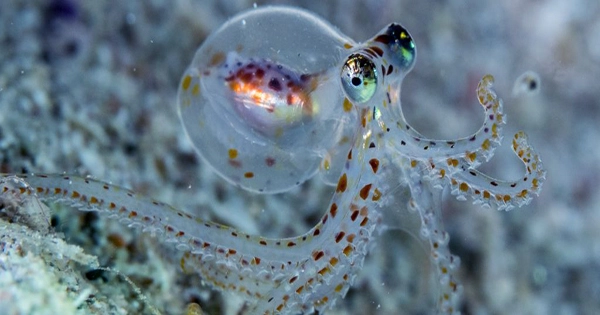Animals with sophisticated neurological systems, such as cephalopods like octopuses, squids, and cuttlefish, are highly intelligent. The Max Delbrück Center’s Nikolaus Rajewsky-led research team has now demonstrated in Science Advances that their evolution is connected to a notable expansion of their microRNA repertoire.
The last known common ancestor of humans and cephalopods is a rudimentary wormlike animal with low intelligence and basic eyespots, which we can find if we travel far enough back in evolutionary history. Later, the two types of organisms that make up the animal kingdom—those with backbones and those without—can be separated. Invertebrates did not evolve huge, sophisticated brains with a range of cognitive capacities, whereas vertebrates, in particular primates and other mammals, did. The cephalopods are the sole exception.

Why only these mollusks were able to build such a sophisticated neurological system has long been a mystery to scientists. A potential explanation has now been presented by an international team headed by academics from the Max Delbrück Center and Dartmouth College in the United States. They describe how octopuses have a greatly increased repertoire of microRNAs (miRNAs) in their neural tissue, reflecting comparable advances that happened in vertebrates, in a report that was published in Science Advances.
The last author of the study, Professor Nikolaus Rajewsky, who also serves as the scientific director of the Max Delbrück Center’s Berlin Institute for Medical Systems Biology (MDC-BIMSB) and director of the Systems Biology of Gene Regulatory Elements Lab, says, “So this is what connects us to the octopus.” He argues that this study suggests that miRNAs are crucial for the growth of complex brains.
Rajewsky read a book in 2019 that described octopuses’ genetic analyses. These cephalopods are known to engage in significant RNA editing, which means they frequently use certain enzymes that can recode their RNA.
This made Rajewsky wonder if octopuses have further RNA tricks up their sleeves in addition to being skilled editors. The Stazione Zoologica Anton Dohrn marine research station in Naples brought him samples of 18 distinct tissue types from deceased octopuses, and this is how he began working with them.
The analysis’ findings were unexpected: “There was clearly significant RNA editing going on, but not in regions that we believe to be of interest,” says Rajewsky. In fact, the enormous growth of a well-known class of RNA genes called microRNAs was the most intriguing finding.
42 unique miRNA families in all were discovered, primarily in the brain’s neural tissue. The team comes to the conclusion that these genes were obviously advantageous to the animals and are thus functionally significant because they were conserved throughout cephalopod evolution.
Rajewsky has spent more than 20 years studying miRNAs. These genes encode short RNA fragments that bind to messenger RNA and regulate protein synthesis instead of being translated into messenger RNAs that carry the instructions for protein synthesis in the cell. Another clue that these new miRNAs are functional is the conservation of their binding sites throughout cephalopod evolution.
New families of microRNAs: This is the third-biggest growth of microRNA families in animals and the largest outside of vertebrates, according to lead author Grygoriy Zolotarov, MD, a Ukrainian researcher who later worked as an intern in Rajewsky’s lab at MDC-BIMSB. To give you an idea of the magnitude, consider that since their last common ancestor with octopuses, oysters, which are mollusks, have only acquired five new microRNA families, whereas octopuses have acquired 90. Zolotarov continues that oysters aren’t exactly renowned for their intelligence.
Years ago, on a visit to the Monterey Bay Aquarium in California in the evening, Rajewsky developed a fascination with octopuses. “I noticed this monster sitting on the bottom of the tank, and we looked at each other for, what seemed like several minutes.”
He claims that observing an octopus differs greatly from observing a fish in that “their eyes certainly convey a sense of intelligence.” Humans and octopuses both have sophisticated “camera” eyes.
Octopuses are the only invertebrate species that are unmatched in terms of evolution. They have a core neural system and a peripheral nervous system, the latter of which is independent. Even if an octopus loses one of its tentacles, the remaining tentacle is still mobile and touch-sensitive. The fact that octopuses utilize their arms quite specifically—as tools to open shells, for example—could be the reason they are the only animals to have evolved such sophisticated brain functions.
Octopuses exhibit additional intelligence in the form of curiosity and memory. They are able to identify persons and even prefer some over others. Due to the fact that they alter their skin’s structure and color as they sleep, researchers now speculate that they even dream.
Alien-like creatures: Rajewsky cites the proverb, “They say if you want to meet an alien, go diving and become friends with an octopus.” He now intends to cooperate with other octopus researchers to create a European network that would facilitate increased scientific communication. Rajewsky claims that despite the tiny size of the group right now, interest in octopuses is rising across the board, especially among behavioral scientists.
He claims that studying an intelligence that evolved wholly independently of our own is fascinating. But it’s challenging: “They quickly lose interest in testing if you use modest nibbles as rewards. Those are the words from my colleagues, at least “Rajewsky says.
Our molecular-biological resources were quite constrained because octopuses aren’t normal model organisms, claims Zolotarov. Therefore, we are unsure of exactly which cell types express the novel microRNAs. Currently, Rajewsky’s team is preparing to use a method that was created in his lab to make the cells in octopus tissue visible at the molecular level.















